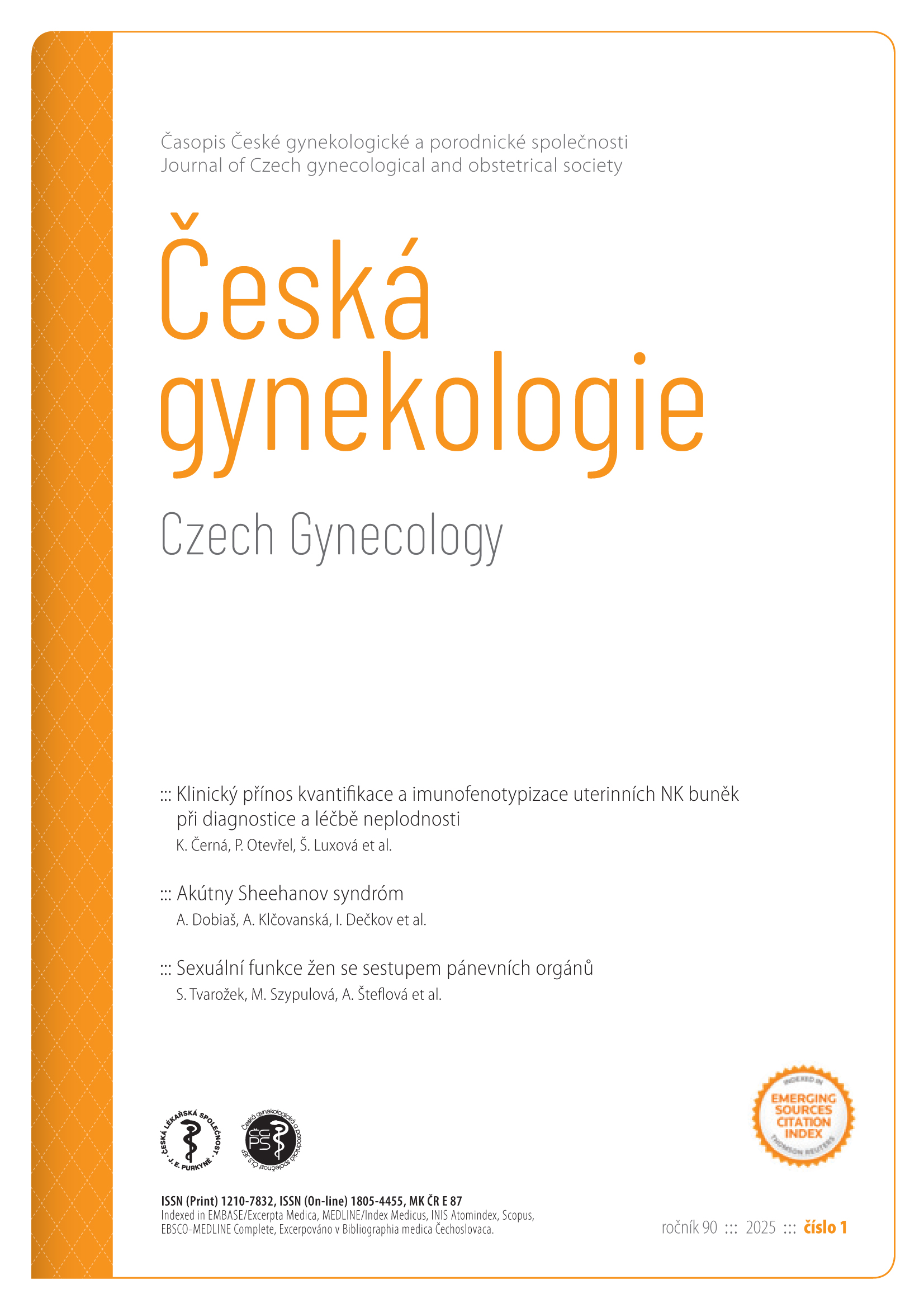Diagnosis and treatment of peripartum haemorrhage, consensus of the interdisciplinary working group by the modified ACCORD method
Diagnosis and treatment of peripartum haemorrhage
Keywords:
peripartum hemorrhage, pressure and subpressure intrauterine devices, hemostatic intrauterine devices, recombinant factor VIIa, viscoelastic methods, uterotonic prophylaxis, crisis management, hemorrhage prevention, simulation medicineAbstract
Preventive measures and procedures
We recommend monitoring of blood loss in women with risk factors for PPH during labor using calibrated blood collectors or their equivalents.
(Good Clinical Practice)
We recommend that women with significant risk factors for PPH (e.g., placenta acrreta spectrum or hematologic disorders requiring consultative hematologic care) deliver in a perinatal intensive care center or perinatal intermediate care center.
(Good Clinical Practice)
We recommend formulating a plan of care in collaboration with a multidisciplinary team at a reasonable time prior to delivery for patients at high risk of PPH.
(Good Clinical Practice)
We recommend treating anemia antepartally. Pregnant women should be given iron supplements if the haemoglobin level falls to < 110 g/L in the 1st trimester or < 105 g/L at 28 weeks of pregnancy.
(Good Clinical Practice)
We suggest considering parenteral iron administration in women with sideropenic anemia unresponsive to oral iron supplementation. The cause of anemia should be identified as soon as possible after termination of pregnancy.
(Weak recommendation)
If the baby adapts well, we do not recommend cord ligation in less than 1 min.
(Strong recommendation)
In all vaginal deliveries, we recommend prophylactic administration of uterotonics in the third postpartum period after the delivery of the baby and cord ligation to reduce the risk of PPH. The first-choice drug is oxytocin.
(Strong recommendation)
If the third stage of labor has not been actively managed, we suggest that uterine massage and controlled umbilical cord traction be considered to shorten the duration of the third stage of labor and to reduce blood loss during vaginal delivery, if performed by a qualified healthcare professional.
(Weak recommendation)
We recommend the administration of uterotonics to prevent the development of PPH in women after the delivery of a child by caesarean section and umbilical cord ligation.
(Strong recommendation)
We suggest considering carbetocin administration in women at increased risk of PPH.
(Weak recommendation)
We recommend a single-dose administration of tranexamic acid (TXA) in women at increased risk of PPH undergoing a caesarean section. Clinical note: The use of TXA prior to the caesarean section is not explicitly stated in the product‘s SPC. A recent meta-analysis states the most common dosage to be 1 g i.v.
(Strong recommendation)
Organization of care
We recommend that every health care facility with an OB/GYN unit should have the PPH management protocol (guided document is not specific or really used at all, I am not sure if my suggestion is sufficient) defining the organizational and professional procedure for PPH situations.
(Good Clinical Practice)
We recommend that the PPH management protocol (i.e. the crisis action plan) should clearly define the organizational and professional roles of the individual members of the crisis team in the event of PPH (non-medical staff), obstetrician, anesthetist, hematologist, etc.) and define the minimum scope of equipment for the care of patients with PPH.
(Good Clinical Practice)
We recommend regular simulation training of PPH crisis by the entire crisis team with a subsequent debriefing or its formalized equivalent.
(Good Clinical Practice)
We recommend defining quality indicators for the diagnosis and treatment of PPH and their formalized evaluation at regular intervals, at least once a year.
(Good Clinical Practice)
Diagnostic and treatment procedure at PPH
When hypotonia or atony of the uterus is found, we recommend using a structured procedure.
(Good Clinical Practice)
At departments with an option of endovascular interventions, we suggest considering the preferential use of radiological interventional methods (selective pelvic artery embolization) in cases of PPH due to uterine hypotonia or atony, if the current clinical context allows it.
(Weak recommendation)
For all stages of PPH development, we recommend a pre-transfusion examination. In addition to standard laboratory tests, point-of-care-testing methods, especially viscoelastic methods, are preferred to assess the current coagulation status.
(Good Clinical Practice)
Each obstetric unit should ensure a sufficient stock of blood products and blood derivatives for their immediate availability 24/7 in collaboration with the transfusion department and the inpatient pharmacy. In case of PPH development, we recommend securing initial availability of 4 units of plasma (solvent/detergent-treated plasma is preferred), 4 units of erythrocytes and 6 g of fibrinogen.We consider 8 g to be a minimum supply of fibrinogen and additional 8 g should be available within 1 h.
(Good Clinical Practice)
We recommend the initiation of immediate fluid resuscitation in all patients with PPH. We recommend the use of balanced crystalloid solutions to initiate fluid resuscitation.
(Strong recommendation)
We propose considering the use of synthetic colloid solutions containing gelatin when hemodynamic goals of fluid resuscitation have not been achieved or are not being achieved using crystalloid solutions and when a fluid deficit persists.
(Weak recommendation)
Until the source of bleeding is controlled, we recommend aiming for a systolic blood pressure in a range of 80–90 mmHg in patients with PPH.
(Strong recommendation)
We recommend the use of vasopressors as soon as possible in PPH when target arterial blood pressure values cannot be reached by ongoing fluid resuscitation.
(Strong recommendation)
We recommend cooperation with a hematologist in the diagnosis and treatment of coagulopathy in PPH unresponsive to standard therapies.
(Good Clinical Practice)
In addition to the above-mentioned panel laboratory tests (at least KO, aPTT, fibrinogen), we also recommend using viscoelastic methods (ROTEM, TEG) to identify the type of coagulation disorder in PPH, to monitor it and for targeted treatment of hemostasis disorders.
(Strong recommendation)
To achieve/restore the efficacy of endogenous hemostatic mechanisms and coagulation support therapies, we recommend the maximum possible correction of hypothermia, acidosis and ionized calcium levels.
(Strong recommendation)
Early initiation of all available procedures to prevent hypothermia and maintain or achieve normothermia is recommended.
(Strong recommendation)
It is recommended monitoring and maintaining ionized calcium levels within the normal range when administering transfusion products. Preferably, calcium chloride should be administered for correction.
(Strong recommendation)
Fibrinogen replacement is recommended in patients with PPH when fibrinogen levels fall to < 2 g/L and/or when there is a functional fibrinogen deficiency detected by viscoelastic methods and/or when there is a reasonable clinical assumption of fibrinogen deficiency even without knowledge of fibrinogen levels. We recommend a minimum of 4 g of fibrinogen as an initial dose in PPH.
(Strong recommendation)
It is recommended to administer tranexamic acid (TXA) at an initial dose of 1 g i.v. as soon as possible after the onset of PPH. An identical dose may be repeated (after 30 min at the earliest) if bleeding continues and if hyperfibrinolysis is demonstrated and/or if hyperfibrinolysis is highly likely in the current clinical context.
(Strong recommendation)
We do not recommend further administration of TXA in patients with PPH after bleeding control has been achieved.
(Strong recommendation)
We recommend administration of plasma at a dose of 15–20 mL/kg in PPH conditions where coagulopathy of a different etiology than fibrinogen deficiency is suspected and/or abnormal coagulation test results are present, and where the results do not reliably identify the predominant mechanism of the coagulation disorder and its targeted correction.
(Strong recommendation)
We recommend the administration of prothrombin complex factors (PCC) in patients with PPH where there is a laboratory evidence of a deficiency of PCC factors. We do not recommend routine administration of PCC in patients with PPH.
(Strong recommendation)
We suggest considering administration of rFVIIa before making a decision on an endovascular or a surgical intervention.
(Weak recommendation)
In patients with PPH, we recommend administration of erythrocyte blood products to achieve a target hemoglobin value in the range 70–80 g/L.
(Strong recommendation)
In patients with PPH, we recommend platelet administration to achieve a target value of at least 50 × 109/L and/or when platelet function impairment is suspected or demonstrated.
(Strong recommendation)
We do not recommend routine measurement of antithrombin III levels in patients with PPH.
(Strong recommendation)
We do not recommend routine antithrombin III replacement in patients with PPH.
(Strong recommendation)
We recommend initiating pharmacological prophylaxis for thromboembolic disease as soon as possible after control of the source of PPH is achieved. We recommend initiating mechanical thromboprophylaxis (intermittent pneumatic compression or elastic stockings) as soon as the clinical condition permits.
(Strong recommendation)


